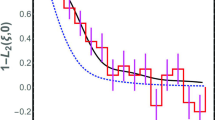Abstract
The traditional diffusion approach for calculation of the collision frequency function for coagulation of Brownian particles is critically analyzed and shown to be valid only in the particular case of coalescence of small particles with large ones and inapplicable to calculation of the coalescence rate for particles of comparable sizes. It is shown that coalescence of Brownian particles generally occurs in the kinetic regime (realized under condition of homogeneous spatial distribution of particles), however, the expression for the collision frequency function in the continuum mode of the kinetic regime formally coincides with the standard expression derived in the diffusion regime for the particular case of large and small particles. This explains the validity of the traditional form of the coagulation rate equation in a wide range of parameters, corresponding to the continuum mode. Transition from the continuum to the free molecular mode can be described by the interpolation expression derived within the new analytical approach with fitting parameters that can be specified numerically, avoiding semi-empirical approach of existing models.
Similar content being viewed by others
References
Smoluchowski, M., Phys. Z., 1916, no. 17, p. 557.
Chandrasekhar, S., Rev. Mod. Phys., 1943.
Seinfeld, H., and Pandis, S.N., Atmospheric Chemistry and Physics. From Air Pollution to Climate Change, New York: Wiley, 1998.
Fuchs, N.A., The Mechanics of Aerosols, New York: Pergamon, 1964.
Langevin, P., Compendes Rendus Acad. Sci. (Paris), 1908.
Davies, C.N., Proc. Phys. Soc. London, 1945, no. 57, p. 259.
Fuchs, N.A. and Sutugin, A.G., High-Dispersed Aerosols, in Topics in Current Aerosol Research, Hidy, G.M. and Brock, J.R., Eds., New York: Pergamon, 1971, pp. 1–60.
Dahneke, B., Simple Kinetic Theory of Brownian Diffusion in Vapors and Aerosols, in Theory of Dispersed Multiphase Flow, Meyer, R.E., Ed., New York: Academic Press, 1983, pp. 97–133.
Park, S.H., Lee, K.W., Otto, E., and Fissan, H., J. Aerosol Sci., 1999, no. 30, p. 3.
Wright, P.G., Disc. Faraday Soc., 1960, no. 30, pp. 100–112.
Kim, D.S., Park, S.H., Song, Y.M., Kim, D.H., and Lee, K.W., J. Aerosol Sci., 2003, no. 34, p. 859.
Kim, D.S., Hong, S.B., Kim, Y.J., and Lee, K.W., J. Aerosol Sci., 2006, no. 37, p. 1781.
Author information
Authors and Affiliations
Corresponding author
Rights and permissions
About this article
Cite this article
Veshchunov, M.S. On the theory of Brownian coagulation. J. Engin. Thermophys. 19, 62–74 (2010). https://doi.org/10.1134/S1810232810020025
Received:
Published:
Issue Date:
DOI: https://doi.org/10.1134/S1810232810020025




